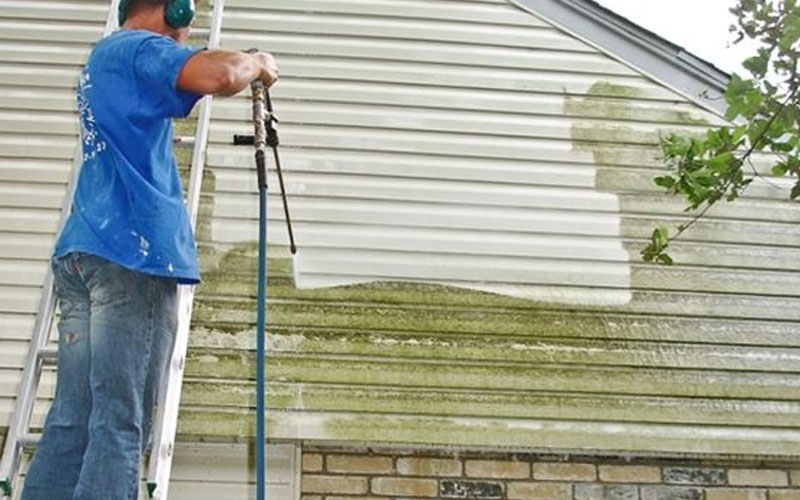Pressure washing is one of the most effective ways to clean any residential property, although it is often misunderstood and misused. When used correctly, pressure washing can be a great asset in maintaining your home’s pristine condition; when done incorrectly, the results can be disastrous.
Juxtaposing these two extremes makes understanding the basics of residential pressure washing vital for any homeowner who wants to get maximum results with minimum effort. This article will discuss the essential elements of properly using a pressure washer on your residential property, including important topics such as selecting the right equipment, preparing the area properly, choosing the right nozzles and techniques, and cleaning up and maintaining your equipment after use.
Select the Right Equipment
Selecting the right pressure washing equipment is essential for achieving the desired results.
The first consideration when choosing a pressure washing machine is to determine the cost of ownership. This includes not only the purchase price, but also ongoing maintenance costs and replacement parts.
Furthermore, it is important to assess what areas will be cleaned and if additional attachments are necessary such as detergents or brushes. A professional quality pressure washer will have adjustable pressures so that different surfaces can be safely cleaned without causing damage. It is also important to consider whether hot water or cold water would work best in certain scenarios. Hot water can help loosen dirt and grease from hard surfaces more quickly but it may cause damage to certain materials like wood or vinyl siding.
The next step in selecting a pressure washer is deciding on mobility needs. If the machine will be used at multiple locations then a portable model will likely be required, however most residential units are stationary models which offer higher PSIs (pounds per square inch). Additionally, one should consider how frequently they plan on using their machine since some machines have lower limits on run times before needing to cool down again.
Finer details such as noise levels, ease of use, and storage needs should also be considered prior to making any purchases.
It is important to research various brands and models of pressure washers before settling on one that fits all criteria needed for residential cleaning projects. Reviews from other customers can provide insight into both performance and durability of each system so that buyers can make an informed decision regarding their purchase.
Prepare the Area
Preparing the area for pressure washing is an important step.
Moving and covering furniture and plants helps ensure that any loose items are not damaged by water or chemical runoff.
It is also important to cover windows and doors with plastic sheeting to protect them from potential damage caused by the powerful stream of water.
Taking time to properly prepare the area prior to pressure washing will help ensure a successful clean.
Move and Cover Furniture and Plants
Prior to commencing any residential pressure washing, consideration should be given to relocating furniture and covering plants.
It is important to remember that high-pressure water can cause damage to the surface of some materials and items, as well as potentially damaging certain types of plant life.
To protect surfaces from potential damage due to the force of water, all furniture should be moved away from the area that is being pressure washed. This includes patio furniture, outdoor decorations, and other items such as potted plants or statues.
It is also essential for experienced professionals to dress appropriately when participating in a residential pressure washing job. This means wearing protective clothing such as non-slip shoes or boots, goggles, gloves and a face mask.
Furthermore, it is important to cover plants with plastic sheeting or tarps prior to beginning work in order to protect them from the high-pressure spray of water which could otherwise harm them.
Taking these necessary steps will help ensure the safety of any surrounding surfaces and plant life while completing the pressure washing job correctly and efficiently.
Protect Windows and Doors
Care should be taken to shield windows and doors from the powerful force of the pressure washer, as direct contact could cause irreparable damage.
To protect surfaces, experts recommend cleaning edges first with a soft brush before using a pressure washer. This will remove any debris that would otherwise be blasted into the window or door frame, potentially damaging them.
When using the pressure washer around windows and doors, it is best to maintain a distance of about one foot away from the frames. Moving too close can cause water to seep in through cracks or gaps between window panes and create serious water damage inside the home.
The nozzle of the pressure washer should also be kept moving at all times so that concentrated jets of water do not affect any one area for too long.
Additionally, if any additional protection is needed such as plastic sheeting or tape, it should be applied on windows and doors prior to starting work in order to ensure maximum safety.
Choose the Right Nozzles
Selecting the appropriate nozzles for a residential pressure washing job is essential to achieving desired results. Different pressures levels and nozzle types can be used to achieve various degrees of cleaning, and having an understanding of how these work together can help in selecting the right tools for each job.
Pressure levels, or PSI (pounds per square inch), are often measured by the amount of force exerted over a surface area. Higher PSIs can be used on tougher stains and surfaces, but should be applied with caution as too much pressure can damage siding, brickwork, or other surfaces.
Nozzle types include flat fan nozzles which provide a wide angle spray pattern making them ideal for larger areas such as driveways or sidewalks; turbo nozzles which create a more concentrated stream of water that is perfect for removing caked-on dirt from stucco walls; and rotary nozzle heads which spin at high speeds creating an intense scrubbing action that works well on concrete surfaces with heavy build-up.
Taking into consideration both the pressure level requirements and type of nozzle required makes it easier to select the most suitable tool for any residential pressure washing job. Understanding how these components interact will ensure optimal results while avoiding unnecessary damage to property.
Understand the Proper Technique
When pressure washing a residential property, it is important to understand the proper technique in order to achieve the best results.
To begin, one should always start from the top and work their way down to the bottom.
Additionally, when going over a surface area one should move in a left to right motion in order to ensure even coverage and prevent lines or streaks from forming.
Finally, it is important that one takes their time with each pass over an area in order for the cleaning solution to do its job properly.
Start From the Top
Starting with the roof is a key factor when pressure washing a residential building, as it allows for the removal of any debris or buildup that may have accumulated over time.
To begin this process, the power source used should be checked to ensure that it is up to standard.
The operator should also take into consideration the power level they will need to use when cleaning the roof. Too much pressure can damage shingles and cause water infiltration, while too little pressure won’t do an effective job of removing dirt and debris.
It is important to find a balance between power and pressure levels so that any dirt and buildup on the roof can be effectively removed without causing any damage.
Move in a Left to Right Motion
Carefully navigating the surface of the roof in a left to right motion is essential for achieving an optimal pressure washing result, as it ensures that no area is missed and provides a thorough clean.
A pre-inspection should be carried out prior to commencing with the pressure washing process, which will identify any areas that may require special attention.
During the cleaning process, water pressure should remain steady, consistent and even throughout each pass from left to right. This will ensure an even coverage of cleaning solution across all surfaces for maximum effectiveness.
The following points are key when conducting residential pressure washing:
– Keeping a steady water pressure throughout the process
– Inspecting the area before beginning work
– Moving in a left to right motion
– Allowing for adequate dwell time of cleaning solution on surfaces
– Thoroughly rinsing off the surfaces after applying cleaning solution.
Clean Up and Maintain Equipment
Regularly inspecting and maintaining pressure washing equipment is essential to ensure optimal performance.
This includes checking the hoses, nozzles, filters, pumps, motors and any other parts for wear-and-tear and signs of damage.
It is important to keep all supplies stored away properly when not in use.
This helps preserve them and prevents them from becoming damaged or lost due to exposure to outdoor elements such as water, dirt and debris.
Additionally, safety gear such as goggles or gloves should be worn at all times while working with pressure washing equipment.
Proper cleaning procedures are also recommended for maintenance purposes.
All external surfaces should be wiped clean with a damp cloth after every use to prevent dirt build up over time.
Pressure washers should never be used on electrical components like lights or outlets as it can cause serious injury or property damage if performed improperly.
Internal components such as valves and screens should also be checked regularly for blockages which may interfere with the proper functioning of the equipment.
In addition to these basic maintenance tips, it is important that instructions provided by the manufacturer are followed carefully when using pressure washing machines.
Having an understanding of how each part of the machine works can help identify problems before they arise and ensure that any repairs needed are done quickly and safely without compromising user safety or quality assurance standards.
Conclusion
Pressure washing is a powerful way to clean residential surfaces such as driveways, decks, and siding. It is a cost-effective solution that can be used to restore the appearance of a home’s exterior.
To ensure successful pressure washing projects, it is important to understand the basics, such as selecting the right equipment and nozzles, using proper technique, and maintaining the equipment.
With some practice and attention to detail, pressure washing can be an effective part of any homeowner’s maintenance routine. Utilizing this method on a regular basis keeps outdoor surfaces looking their best throughout the year.
By taking into account factors like nozzle choice and water pressure level, homeowners can create safe results with minimal effort and maximum impact. Pressure washing can help maintain the beauty of any residential property for years to come.




